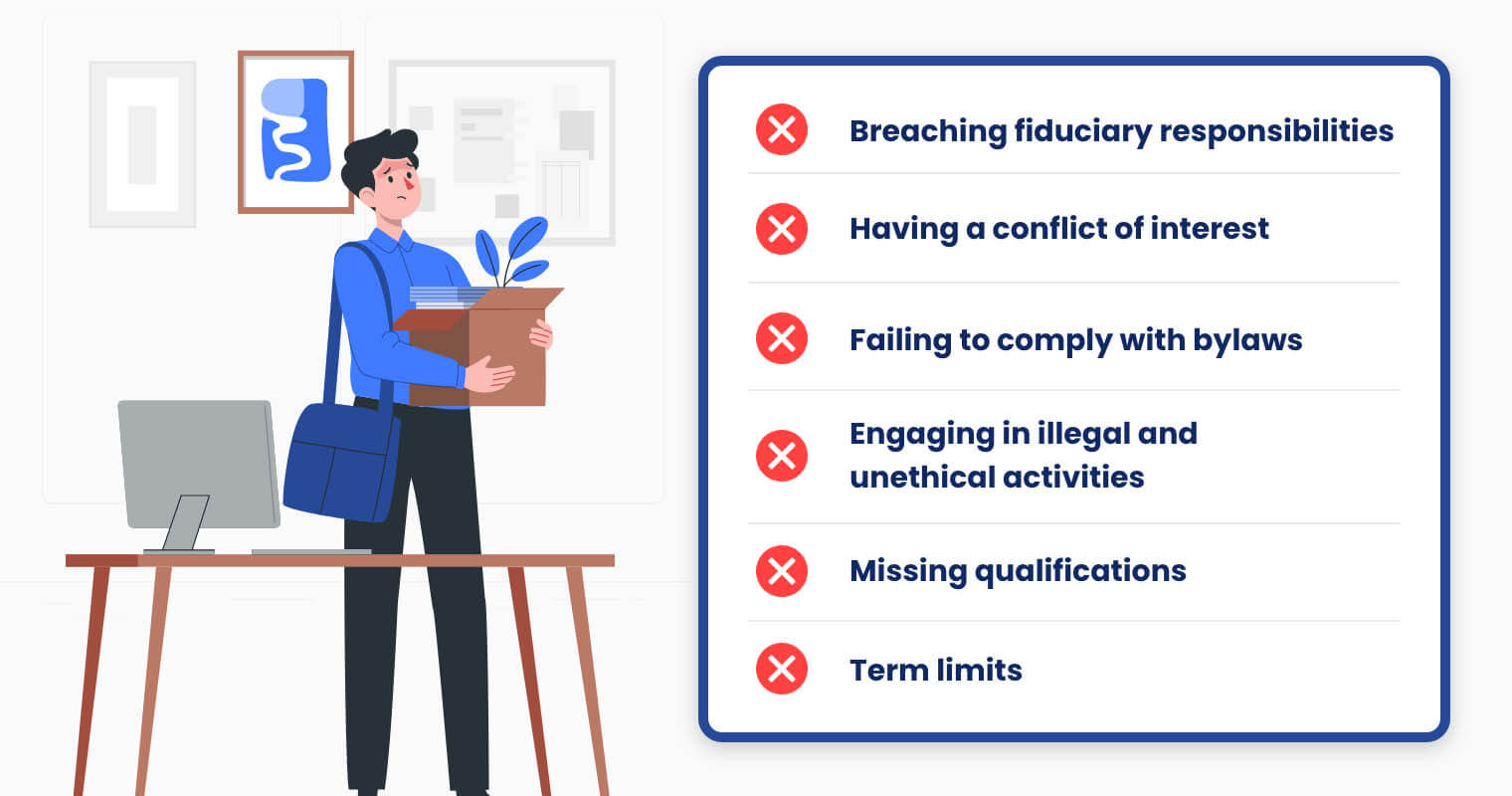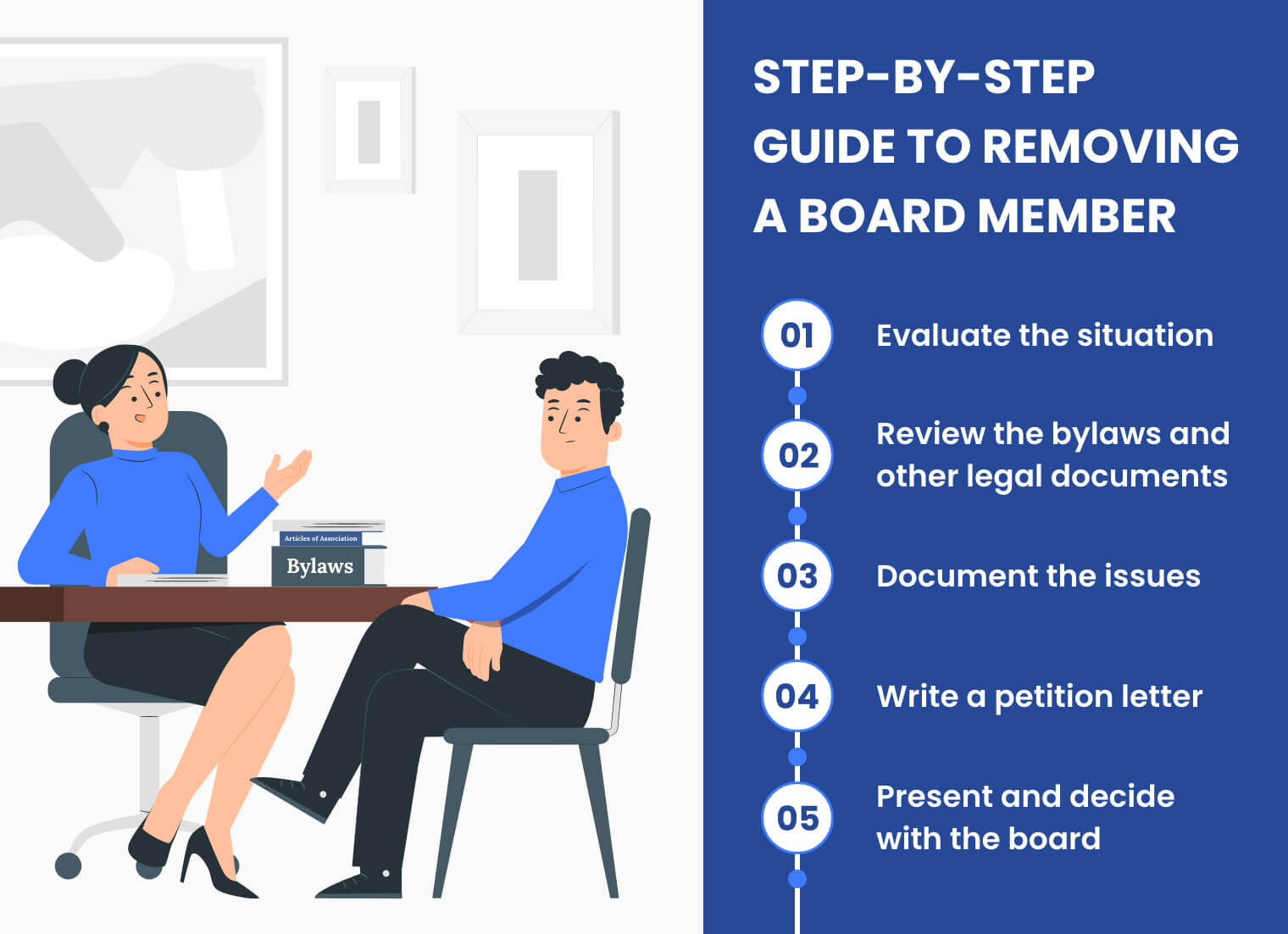High-performing board of directors is a strategic asset of an organization. Composed of individuals with diverse skills and expertise, this forms a cohesive leadership that provides invaluable guidance and oversight. However, building a strong board doesn’t happen on a whim, and requires continuous efforts involving evaluating, recruiting, training, and sometimes even removing board members.
But when does removing a board member become necessary? Discover the technical process involved in this action, including the various grounds for removal, sample letter to remove board members, and the step-by-step guide to execute it effectively.
What are the grounds for removing a board member?

There are multiple reasons why a board member can be dismissed from their position. These can range from breaching board duties, causing detrimental damages, or a change in strategy.
The following are legitimate grounds for the removal of a board member:
1. Breaching fiduciary responsibilities
Fiduciary duties mandate board members to act in the best interests of the organization when handling its assets and funds. It requires prudent decision-making by upholding core values such as care, honesty, and loyalty. A breach happens when a board member abuses their authority and commits inappropriate acts such as mismanaging assets and approving unauthorized transactions.
2. Having a conflict of interest
Conflicts of interest prohibit board members from committing self-dealing activities that could compromise their impartiality. To ensure fair and unbiased judgment in the workplace, there are conflict of interest policies requiring board members to proactively disclose potential personal conflicts. Noncompliance with these policies can have harmful impacts on the board, damaging its reputation and finances.
3. Failing to comply with bylaws
Bylaws outline an organization’s policies and rules, according to the governance model of the board. Board members are responsible for these rules and must adhere to them to avoid violations. Common infractions that can lead to the dismissal of a board member include lack of participation in board activities, discrimination, harassment, and breaches of non-disclosure agreements. With attendance being a critical requirement of the role, persistent absence is a concerning violation, signaling a lack of commitment to the organization’s goals and mission.
4. Engaging in illegal and unethical activities
Board members should act upon the organization’s mission with the highest ethical standards. As stewards, they must avoid involvement in punitive acts that could damage their reputation and value. The board must take quick and decisive action to protect the organization’s image when a member faces allegations, which may result in the member’s dismissal.
5. Missing qualifications
Securing a role on the board is a highly competitive endeavor, requiring individuals to possess specialized skills and certifications. As industries evolve, so do the expectations for board members, leading to more complex qualifications and responsibilities. To maintain effectiveness, the board must review its composition and identify members who need more skills to keep up with the demands of their roles.
The board can perform such evaluations using a board skills matrix. This method highlights gaps and opportunities, providing data-driven insights on what board members must possess to remain qualified and continue making meaningful contributions.
Learn How to Use a Board Skills Matrix Here
6. Term limits
Term limits, as specified in bylaws, define the length of service a board member can have. This promotes fair power distribution and systematic director rotation. By implementing term limits, the organization can significantly reduce risks caused by complacency among long-serving members, fostering more collaborative and dynamic board interactions.
How to Handle the Removal of a Board Member

The board of directors can remove a member through several methods and must practice careful judgment in choosing which one. Here are several approaches to consider:
1. Passing of ordinary resolution
The board can remove a member via an ordinary resolution—a type of decision that requires a simple majority or at least 50% of attendees. This method begins with a special meeting to gather board members who will vote on the removal.
Terminating a board member via ordinary resolution necessitates an in-person meeting and voting, unlike other resolutions where online and written votes are allowed. To promote objective deliberation, the board must distribute a petition letter before the meeting to guide attendees in decision-making.
2. Retirement of directors by rotation
Retirement by rotation is a common practice in publicly listed companies where a portion of the organization’s board members resign at each annual general meeting (AGM) to seek re-election. This encourages diversification of board composition, promotes new perspectives, and mitigates the implications of retrenchment.
The UK implements this through its Corporate Governance Code under the Companies Act 1948. In the US, while not explicitly required by federal law, many PLCs adopt board rotation policies as part of their corporate governance best practices.
3. Dismissal by Articles of Association (AOA)
The Articles of Association (AOA) are internal rules agreed upon by shareholders and directors that explain how to govern the organization. They detail the fundamentals of board governance, covering aspects like composition, compensation, voting rights, and grounds for removal. Like bylaws, breaches of it can result in consequences, including potential removal from the board.
4. Disqualification ordered by the court
The board can seek legal intervention from local courts or government agencies when removing a board member, especially if it involves severe misconduct such as embezzlement or tax evasion. In the US, for cases beyond internal processes, the board can follow due process by initiating legal action through the Department of Justice, the Securities and Exchange Commission (SEC), or other relevant authorities.
Alternatives to Dismissing a Board Member
Dismissing a board member is a drastic measure that can have far-reaching consequences. The board of directors should first explore other viable options to potentially save time and resources.
Before initiating a formal removal process, consider the following alternatives:
- One-on-one intervention: Initiating a private conversation can be a good opportunity to address issues like disengagement or underperformance among board members without being confrontational. By creating a safe and confidential space, a board member may feel more at ease sharing their concerns or challenges, helping the board chair better understand the root causes. Using a more personal approach may resonate better with board members, making them more inclined to submit their board member resignation letter voluntarily rather than feeling forced out.
- Leave of absence: Offer board members who are experiencing conflicts with their health, work, or personal life the option to take a leave of absence. This allows them to temporarily step away from their responsibilities without formally resigning. Establish clear and fair policies for taking and returning from a LOA to avoid potential conflicts, including guidelines on task redistribution, compensation, and leave duration. Depending on the bylaws, the board may decide to find a replacement for the director on leave, facilitating continuous productivity.
Step-by-Step Guide to Removing a Board Member

Use this outline to help you understand the board member removal requirements and ensure a legal and ethical process.
1. Evaluate the situation
Removing a board member demands careful consideration and planning. Begin on the right footing by evaluating the circumstances around the potential removal to identify the underlying causes and implications on the board, stakeholders, and the organization.
2. Review the bylaws and other legal documents
After evaluating, allot time for reviewing your governance documents, such as bylaws and AOA, to understand the procedures and requirements for removing board members, including the necessary votes, notice periods, and potential appeals. In more complex situations involving legal breaches, it may be best for boards to seek help from legal experts to ensure actions align with legal obligations, efficiently avoiding potential lawsuits or repercussions.
3. Document the issues
Compile all evidence to substantiate the allegations, including meeting minutes, written warnings, and records of violations, misconduct, or underperformance. Maintaining clear documentation promotes transparency and accountability, and helps justify the board’s decision by serving as a legal foundation in case of dispute.
4. Write a petition letter
Prepare a formal petition letter specifying the reasons for the board member’s removal. Reference in the letter relevant policies or procedures they violate, along with the supporting documents you’ve gathered during the investigation.
A well-written petition letter includes:
- An opening statement explaining the rationale of the letter
- Reasons for removal and comprehensive documentation
- Recommended actions to be taken
- A closing statement and signature form from the petitioners
5. Present and decide with the board
Arrange a board meeting to present and discuss the petition letter. The board chair must lead the board meeting in a neutral setting, encouraging honest and open dialogue while following a structured outline to avoid derailment. Once the proposal is acknowledged, the board can move forward with a formal vote to finalize the decision.
Free Templates: Sample Petition to Remove Board Member
Need help drafting a petition letter to remove a board member? Here are sample letters you can customize to get you started!
Petition Letter to the Board Chair
[Your Organization’s Address] Subject: Petition to Dismiss [Board Member’s Name] from the Board Dear [Chairperson’s Name] and Members of the Board, We, the undersigned, respectfully request the removal of [Board Member’s Name] from the Board of Directors. This request is made in accordance with the organization’s bylaws and other applicable laws. We understand the significance of this action and would like to explain the reasons that led us to file this petition. [Explain briefly the situation and specify the incident that led to your request] After careful consideration, we have identified the following grounds as the basis for this petition:
We believe that the removal of [Board Member’s Name] is imperative to protect the integrity and reputation of our organization. We respectfully urge the board to initiate the removal process, following the procedures in the bylaws. Thank you for your attention to this matter. Sincerely, [Your Name] |
Letter of Termination Due to Misconduct or Violations
[Your Organization’s Address] Dear [Board Member’s Name], I hope this message finds you well. We, the Board of Directors of [Organization’s Name], are writing to you about a serious matter that has come to our attention. After careful deliberation, it has been determined that your conduct violates the organization’s code of ethics and the bylaws governing the behavior of board members. We truly commend your service and dedication to the organization. However, given the severity of the violations committed, we regret to inform you that the Board has voted to terminate your membership on the Board of Directors, effective [Date]. The specific grounds for removal include: [Explain briefly the violations] You may submit a final written response within [Number] day if you want to appeal this decision. Otherwise, the removal will be effective in [Date]. We regret that it has come to this, and we hope that you will understand the Board’s decision to protect the integrity and reputation of [Organization Name]. Sincerely, [Your Name] |
Letter of Termination Due to Term Limits
[Your Organization’s Address] Dear [Board Member’s Name], I hope this message finds you well. We, the Board of Directors of [Organization’s Name], would like to express our sincere gratitude for your dedicated service and meaningful contributions during your tenure. As you are aware, our bylaws require a term limit of [Number] years for board members. Following this policy, we want to inform you that your term is to expire on [Date]. To maintain good governance and a healthy rotation of perspectives, the Board is committed to moving forward with the scheduled transition. We want to take this opportunity to recognize the significant role you have played in the development of [Explain contributions or initiatives]. We hope that you will remain connected to [Organization Name] in other capacities and that this transition does not mark the end of our collaborative efforts. Please don’t hesitate to reach out if there are any ways in which you would like to stay involved. Thank you again for your dedication and service. Warm regards, [Your Name] |
Frequently Asked Questions About Removing Board Members
Learn more about the technicalities of removing board members by reviewing the FAQs below.
1. How can organizations apply Robert’s Rules to remove a disruptive member from a meeting?
The board chair plays a critical role in enforcing protocols, upholding decorum, and fostering productive discussion. According to Robert’s Rules of Order, the board chair can remove disruptive individuals in meetings.
The board chair can remove non-members quickly without need for voting, while removing a member requires a formal vote. If the removed individual refuses to acknowledge the decision, the chair may seek help from committees or sergeant-at-arms. In extreme cases, the board chair can engage with local authorities for legal charges. Ultimately, Robert’s Rules of Order removing a board member provides a structured framework the board can utilize to manage disputes when dismissing a board member.
2. Can the board of directors remove a board member without them knowing?
Yes, if a board member refuses to resign after an incident, the board of directors has the legal power to remove them, as long as it follows the formal process indicated in the bylaws and AOA.
3. Does a CEO have the authority to dismiss a board member?
No. Bylaws state that only the board of directors and shareholders are authorized to remove a board member. However, given the significant role of CEOs in organizations, they are capable of influencing the decisions of these two parties through their recommendations.
4. How to remove an entire board of directors?
Shareholders can remove the current board by calling a special shareholder meeting, provided they meet the required minimum share percentage. At the meeting, shareholders must issue a proxy statement informing them of the reasons for removal and the prospective candidates. A majority vote from attendees is required to pass and implement the resolution.
Enhance Board Effectiveness Using a Secure and Smart Platform

Exchanging information is essential for successful decision-making in the boardroom, whether it’s sharing announcements, presenting proposals, recruiting members, or handling board removal. Without an established system, even a well-composed board can underperform.
Maximize your board’s potential with Convene board portal software.
Trusted by global companies, Convene offers comprehensive digital solutions designed to centralize document management, streamline communication, and automate meetings. Its integrated e-signature capabilities and secure voting features simplifies decision-making and enhances accountability, making it easier than ever to finalize resolutions and maintain compliance.
Fortified with advanced security features, Convene is a reliable platform capable of protecting sensitive data while allowing members to stay engaged and informed with its user-friendly interface and mobile accessibility.
Empower your board to make smarter decisions with Convene—where security, efficiency, and seamless collaboration come together in one space. Book a free demo today!
Jean is a Content Marketing Specialist at Convene, with over four years of experience driving brand authority and influence growth through effective B2B content strategies. Eager to deliver impactful results, Jean is a data-driven marketer who combines creativity with analytics. In her downtime, Jean relaxes by watching documentaries and mystery thrillers.











